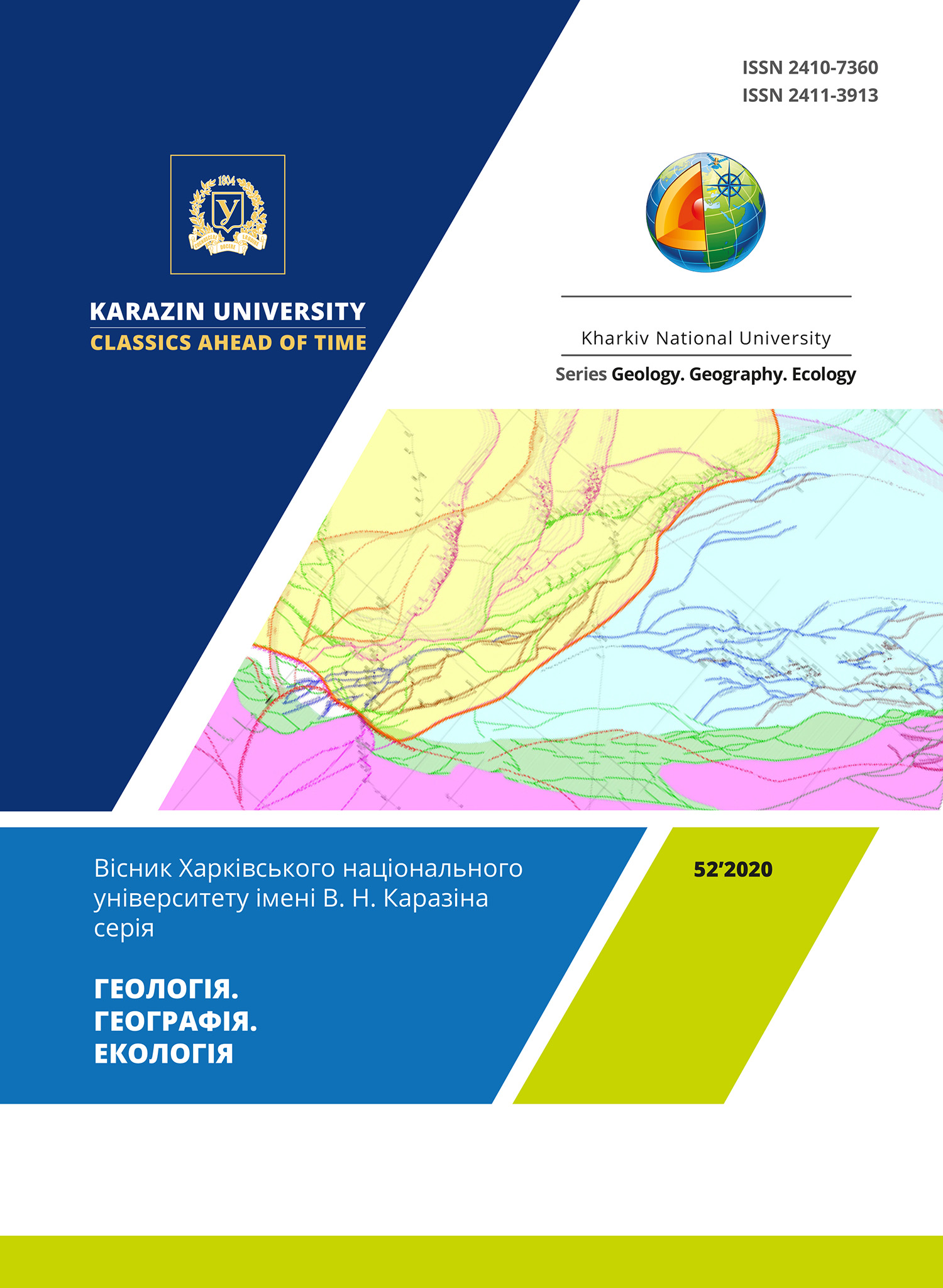Tectonic inversion of the Dnieper-Donets basin. Part 1. Collizion tectonics of the Western-Donets graben
Abstract
Formulation of the problem. New results of tectonophysical studies of the structural-kinematic evolution of the Earth's crust of Dnieper-Donets paleorift at the collision stage are presented in the paper. The subject of research is a complex of deformation structures that complicate the sedimentary cover in the transitional zone with Donets folded structure.
Review of previous publications and studies. According to new mapping data, tectonic deformations of the sedimentary cover were controlled by systems of faults of the north, northwest, and southeast vergence. The lattices of the Hercynian, Lamaric, and Attic tectonites determine the specific “cross-thrust” structure of pushing. Due to the heterogeneous distribution of deformations of different ages, the stratigraphic volume of the sedimentary sequence varies in area from the Pliocene-Anthropogenic to the Mesozoic-Cenozoic. Overthrusts and linear folding of three generations permeate the sedimentary sequence of the transition zone from east to west for hundreds of kilometers within the eastern part of Izyumsky paleorift segment.
Methods. Using the original method of tectonic deformation fields’ reconstruction and tectonophysics analysis of structures, collision deformations of the platform sedimentary cover of the southeastern part of Dnieper-Donets depression are studied. The materials of geological mapping of the transition zone and instrumental definitions of the vergence of the Hercynian, Laramian, and Attic faults constituted the analytical base of tectonophysical studies.
Results. In the transition zone, West-Donets segment of the tectonic wedging, which completely destroys the riftogenic structure in the southeast of the basin was identified. It was formed as a result of a thrust on the syneclise autochthon repeatedly deformed, crumpled into the folds of geomass from the western slopes of Donets folded structure. It consists of structural ensembles of linear thrust folds, tectonic covers of transverse, pushing of sedimentary geomas from axial to onboard zones, and folded covers of longitudinal thrust. The thrust covers and folds of allochthon end in the depression with scaly compression fans formed at the ends of the main thrusts.
In the thrust front of West Donets segment, a geodynamic discharge strip was diagnosed, where structural zones of displacement of geomass were formed. On the north-eastern flank of the thrust front they are represented by large linear anticlinal zones of the so-called “open Paleozoic structures”, such as Torsko-Drobishevsk, North-Donets, Matrossko-Toshkovsk zones, and on the southwestern - Petrovsky-Novotroitsk zone of reverse-folds. The structural peak of the West-Donets segment is the tectonic node of thrusts and strike-slips of three generations, localized in the joint area of the central and southern structural branches of the axial salt-dome folding.
Scientific novelty and practical significance. The current regional tectonic scheme has been revised on the conceptual foundations of dynamic geotectonics. It is shown that the riftogenic structure of the transition zone at the collision stage of evolution was completely destroyed by deformations of three generations. Lattice of tectonites, thrust cover and uplift folding zones of the Hercynian, Laramian, and Attic generations together form West-Donets cover-fold region within it. The main tectonic element of the region is the segment of the tectonic wedging of the same name. By the nature of the structure in its northern part, Lugansk-Kamyshevakhsky district is distinguished by a link echelon of linear folding, and in the south by Kalmius-Toretsky region of tectonic thrust cover. West Donets segment is an important component of the structural-tectonic frame of the sedimentary cover, which determines the modern transverse tectonic segmentation of the paleorift.
Downloads
References
Kopp, M., Kolesnichenko, A., Mostryukov, A., Vasilev, N. (2017). Reconstruction of Cenozoic stress and deformations in the eastern east european platform with its regional and practical application. Geodynamics, 2 (23), 46-66.
Orlyuk, M., Ishchenko, M. (2019). Comparative analysis of modern deformation and the latest movements of the earth's surface on the territory of Ukraine. Geophysical Journal, 4 (41), 161-181.
Korchemagin, V., Ryaboshtan, Yu. (1987). Tectonics and stress fields of Donbass. Fields of stress and strain in the Earth's crust. Moscow: Science, 164-170.
Kopp, M., Korchemagin, V. (2010). Cenozoic stress / strain fields of the Donbass and their probable sources. Geodynamics, 1(9), Lviv, 17-48.
Dudnik, V., Korchemagin, V. (2004). The Cimmerian stress field within the Olkhovatsko-Volyntsevsky anticline of the Donbass, its relationship with discontinuous structures and magmatism. Geophysical Journal, 26, 4, 75-84.
Bartashchuk, O. (2019). Evolution of the stress-deformed field of the Earth crust of Dnieper-Donetsk paleorift at Phanerozoic. Reports of The National Academy of Sciences of Ukraine, 3, 62-71.
Goryainov, S., Sklyarenko, Y. ed. (2017). Forecast of localization and gas-bearing capacity of lithological traps in the southeast of DDZ within the licensed sections of GPU "Shebelinkagazvydobuvannya". Part 1. Creating a Structural-Geological Basis. R&D Report (Final). Contract # 100 SHGV 2017-2017 (topic # 34.521 / 2017-2017). Kharkiv, UkrNDIGaz, 203.
Goryainov, S. ed. (2009). Metamorphic and metasomatic complexes of Priazovye and South Donbass. Kharkov: Ecograph, 304.
Goryaynov, S. (2004). About the Laramian complication of geological structures of Ukraine. Reports of The National Academy of Sciences of Ukraine, 12, 114-121.
Goryaynov, S. (1999). About Alpine complication of geological structure in various re-gions of Ukraine. Reports of The National Academy of Sciences of Ukraine, 8, 106-111.
Rebetskiy, Yu. (2002). Overview of methods for reconstruction of tectonic stresses and increments of seismotectonic deformations. Tectonics today. Moscow, OIFZ of Academy of Sciences of Russia, 227-243.
Timurziev, A. (2014). Experience in the use of tectonophysical methods to increase the efficiency of prospecting, exploration and development of the near-strike-slip oil. Geophysical journal, 2 (36), 172-185.
Bartashchuk, O.V., Suyarko, V. G. (2019). Horizontal displacement of geomassives in continental riftogenicgeostructures (on the Dnieper-Donets paleorift application). P. 2. Structural paragenesis of strike-slip deformation of sedimentary cover. Visnyk of V. N. Karazin Kharkiv National University, series "Geology. Geography. Ecology", 50, Kharkiv, 27-41. https://doi.org/10.26565/2410-7360-2019-50-02
Bartashchuk, O.V. (2019). Horizontal movements of geomasses in continental riftogenic geostructures (on the example of the Dnieper-Donets paleorift). Part 3. Systemic organization of post-rift reid deformations. Visnyk of V. N. Karazin Kharkiv National University, series "Geology. Geography. Ecology", 51, 26-40. https://doi.org/10.26565/2410-7360-2019-51-02





